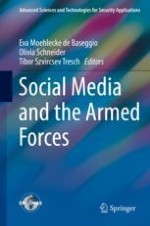2020 | OriginalPaper | Chapter
The Dark Side of Interconnectivity: Social Media as a Cyber–Weapon?
Author : Sofia Martins Geraldes
Published in: Social Media and the Armed Forces
Publisher: Springer International Publishing
Activate our intelligent search to find suitable subject content or patents.
Select sections of text to find matching patents with Artificial Intelligence. powered by
Select sections of text to find additional relevant content using AI-assisted search. powered by
